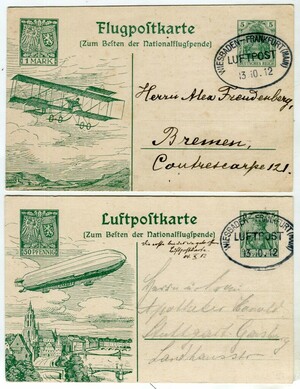THE GELBER HUND STORY

At the end of 1906, the Hessen Royal family began planning a charity week in aid of needy mothers and children. In those days, infant mortality in Germany was around 20%, an issue of major national concern. More than five years of planning went into the event, the major attraction being to link the five major cities of the state (Offenbach, Frankfurt, Darmstadt, Worms and Mainz) into a circuit linked by airmail flights. Pioneer Zeppelins had carried just a slim handful of private mail in previous years, and in February a special flight linked Bork and Brück with mail. So, 1912 was the big show for air flight. The public could now visit five airfields, buy special cards, and for a further airmail fee for a special stamp, they could actually send their cards on one of the flight links (with an additional Germania stamp for onward transmission).
August Euler, the first official German pilot and by now an aircraft builder, would provide his "Gelber Hund" biplane. So named because it was yellow, and according to legend, a day of difficulty starting it prompted Euler to shout "Ach du gelber Hund" ("oh you yellow dog") in amicable frustration. The name stuck and became inextricably linked with the Hessen event.
Special cards were printed with a 5pf or sometimes 10pf Germania stamp attached; special stamps with a bird design in three denominations (10pf, 20pf, 30pf) were printed, and special cancels were made for each of the five towns on the airmail circuit. Use of 10pf and 20pf semi-officials seems to have been a choice, depending on the frugality or generosity of the visitor, or perhaps simply coping with what was offered. Regular letters or postcards were not encouraged; if visitors used "bring your own" mail, the higher value green 30pf semi-official stamp had to be affixed and the event organisers reimbursed the Post Office for the extra normal mail cost. But sometimes the 30pf stamp was bought from pure generosity, or acquired by philatelists wanting to complete the set.
The plane had a 10 meter wingspan, and rear engine providing 65hp drive. For the event, the pilot was Lt Ferdinand von Hiddessen. The cockpit area and rear engine thrust were both modest, far from sufficient for the amount of mail produced by Duchess von Hessen's publicity efforts. Count von Zeppelin stepped into the gap, providing the newest Zeppelin, LZ-10 "Schwaben", piloted by Dr. Hugo Eckener, later president of the Luftschiffbau Zeppelin AG firm.
The event proved enormously popular. Originally planned to last one week, it was extended a second week until 23rd June.
The biplane made only six trips, while the sturdy Zeppelin carried the rest.
The following were the Gelber flight dates :
10 June 1912 : Frankfurt to Darmstadt
11 June 1912 : Darmstadt to Worms
11 June 1912 : Worms to Mainz
17 June 1912 : Mainz to Frankfurt
22 June 1912 : Frankfurt to Darmstadt
22 June 1912 : Darmstadt to Frankfurt
The Zeppelin also carried mail on the days of the Gelber Hund flights, and mail carried by the biplane is not marked in any way to distinguish it from the Zeppelin.
Sieger records the total quantities of mail taken from each airfield :
Darmstadt 193,035
Frankfurt125,679
Mainz67,032
Worms37,960
Offenbach 36,994
TOTAL460,700
Apparently the charity committee had a remainder of stamps and cards, and mailed some to itself on 27th June, again carried by the "Schwaben" Zeppelin.
Most cards were printed in a brown colour. Those in green seem to be limited in use to destination of the two royal palaces ("Altes Palais" = Old Palace in Darmstadt, or "Palais Verwaltung " = Palace Charity Administration office in Mainz), and needed a higher franking of 3 x 30pf green stamps.
During the event the 10pf stamp was surcharged "1M / Gelber Hund" in dark blue. It is logical to suppose these were maybe for sole use on the six Gelber Hund biplane flights but this is not certain. Can any reader clarify?. Some of these were used on special red cards, numbered up to 2000, for which an airmail franking of 3M was expected - three 1M Gelber Hund stamps, or ten 30pf green stamps (rare, only known posted at Darmstadt). Exceptionally, these seem to be mostly left uncancelled when placed in the normal space at the left of the card, only receiving a cancel if placed right next to the Germania stamp which always required cancelling. Rarities are inverted overprint, and double overprint (one yellow, then one in dark blue).
One the last two days of the event (22nd and 23rd June 1912) the 10pf and 20pf semi-official bird stamps were overprinted E.EL.P. (allegedly meaning Ex Est LuftPost = "end of the air post show"). The 10pf is the rarest (3000 printed, cancelled examples known only with Darmstadt and Offenbach cancels) and the 20pf still scarce (6000 printed, cancels known of all five towns). For the overprinted issue, forgeries are known, both as a forged overprint on genuine ordinary stamps, and of the whole stamp plus overprint as forgeries or as a modern reproduction.
Commercial sponsors of the show could have the official air cards overprinted with their advertising on the back. Six official viewcards of the event (pilot von Hiddessen, the "Schwaben" Zeppelin, charity officials etc) with similar printed back were photographed on 10th June in Darmstadt and went quickly on sale three days later. The organisers also promoted sales of 11 portraits of the Royal family.
So, a good topic to develop into an exhibition display, or just to explore the early days of Continental airmail.
- Published
- 26/02/23 01:11:00 AM
